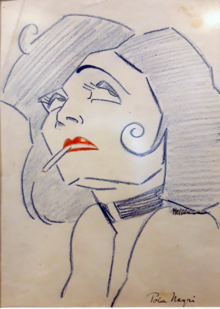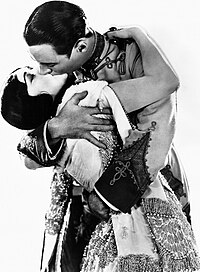Pola Negri
Pola Negri (/ˈpoʊlə ˈnɛɡri/; born Barbara Apolonia Chałupiec[a] [apɔˈlɔɲa xaˈwupʲɛt͡s];[b] 3 January 1897[c] – 1 August 1987) was a Polish stage and film actress and singer.
She achieved worldwide fame during the silent and golden eras of Hollywood and European film for her tragedienne and femme fatale roles.
[14] Negri's father, Juraj Chalupec (Polish transcription Jerzy Chałupec or Chałupiec, died 1920), was an itinerant Romani-Slovak tinsmith from Nesluša.
[20] Her first dance performance was in the danse des petits cygnes in Tchaikovsky's Swan Lake; she worked her way up to a solo role in the Saint-Léon ballet Coppélia.
Alongside her formal schooling at the academy, she took private classes outside with renowned Polish stage actress and professor Honorata Leszczyńska.
Her graduating performance was as Hedwig in Ibsen's The Wild Duck, which resulted in offers to join a number of the prominent theatres in Warsaw.
[25] Negri's popularity in Poland provided her with an opportunity to move to Berlin, Germany in 1917, to appear as the dancing girl in a German revival of Max Reinhardt's theatre production of Sumurun.
[29] Negri and Lubitsch made three German films together after this, Sumurun (aka One Arabian Night, 1920), Die Bergkatze (aka The Mountain Cat or The Wildcat, 1921), and Die Flamme (The Flame, 1922), and UFA employed Negri for films with other directors, including Vendetta (1919) and Sappho (1921), many of which were purchased by American distributors and shown in the United States.
The Hot Dog, a Cleveland monthly publication, in its own promotional advertisement for Paramount in February 1922, claimed Negri's true name was Paula Schwartz, and that she was Jewish,[33] which was completely untrue.
[34] Negri ended up becoming one of the most popular Hollywood actresses of the era, and certainly the richest woman of the film industry at the time,[35] living in a mansion in Los Angeles modeled after the White House.
Her first spectacle film was the Herbert Brenon-directed The Spanish Dancer (1923), based on the Victor Hugo novel Don César de Bazan.
Rosita, Lubitsch's film with Mary Pickford, was released the same year and happened to be based on Don César de Bazan.
"[39] Initially Paramount used Negri as a mysterious European femme fatale and a clotheshorse as they had done with Gloria Swanson and staged an ongoing feud between the two actresses, which actor Charlie Chaplin recalled in his autobiography as "a mélange of cooked-up jealousies and quarrels.
"[40] Negri was concerned that Paramount was mishandling her career and image and arranged for her former director Ernst Lubitsch to direct her in the critically acclaimed Forbidden Paradise (1924).
"[41] Paramount transitioned into casting Negri in international peasant roles the following year in films such as the Mauritz Stiller-directed and Erich Pommer-produced Hotel Imperial (1927), in an apparent effort to give her a more down-to-earth, relatable image.
Negri claimed in her autobiography she opted not to renew her contract with Paramount, choosing to retire from films and live as a wife at the Château de Rueil-Seraincourt, near Vigny that she owned and where she had married her second husband.
[45][24] The same year, her short volume featuring reflections on art and film, La Vie et Le Rêve au Cinéma (lit.
[47] When the rights proved to be too expensive, the company settled on an original story and hired German Kammerspielfilm director Paul Czinner to direct.
However, she collapsed after the final curtain at the production's stop in Pittsburgh, Pennsylvania, due to gallbladder inflammation,[48] and was unable to complete the tour.
[51] According to her autobiography, she also appeared in a Boston supper club engagement in 1945 for a repertoire centered around the song "Paradise",[24] and retired from the entertainment business altogether.
[57] After she began working in the United States, she made headlines and gossip columns with a string of celebrity love affairs, most notably with film stars Charlie Chaplin, Rod La Rocque, and Rudolph Valentino.
Negri had met Chaplin while in Germany, and what began as a platonic relationship became a well-publicized affair and marriage speculation which received the headline "The Queen of Tragedy to Wed the King of Comedy.
"[58] The relationship soured, and Negri became involved for a time with actor Rod La Rocque, who appeared as her leading man in Forbidden Paradise (1924).
[63] When Negri returned to the United States in the early 1940s, she became close friends with Margaret West, an oil heiress, former radio star,[61] and vaudeville actress, whom she had originally met in the 1930s.
[66] Negri moved out of the home she had shared with West into a townhouse located at 7707 Broadway in San Antonio, where she spent the remainder of her years, largely out of the public eye.
Some scholars, such as Emily Leider, a Rudolph Valentino biographer, have suggested that Negri was bisexual, and that she and West, who lived together from 1948 to 1963[61] were romantic partners.
[31] Her death was caused by pneumonia for which she had been rushed to the hospital a week earlier; however, she was also suffering from a brain tumor, for which she had refused treatment for two years.
[74] As Negri had no children or siblings, she left most of her estate to St. Mary's University, in Texas, including a collection of memorabilia and several rare prints of her films.
[76] Negri (portrayed by an uncredited dancer/actress) makes a cameo appearance in the TV film Young Indiana Jones and the Hollywood Follies.
[80] A large black and white portrait of Negri hangs in the small chapel of the Seraphic Sisters of the Third Order of St. Francis of Assisi Congregation,[81] next to Poland's patron, at Shrine of Our Lady of Częstochowa, at 138 Beethoven Street, in San Antonio.









